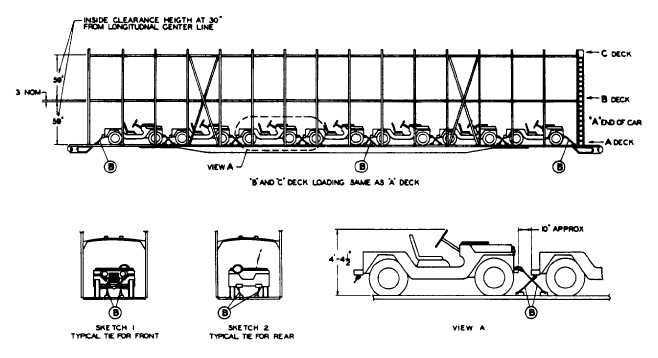Sec. 6-Fig. 303 (Rev.-8-1972)
¼ TON, 4 X 4, UTILITY TRUCKS, BI-LEVEL OR TRI-LEVEL CAR
Item No. of Pcs.
Description
A
Brake wheel clearance. See Fig. 2, Sec. 1.
B
4 ea. unit.
Chain tie-down and tensioning device with a minimum proof test of 6,700 lbs. Pass one chain
through each clevis, attached to front bumper and rear of truck, under each bumperette. See
Sketches 1 and 2. Hand tension, as tight as possible, each tie-down chain and attach grab
hook into an appropriate link of the tie-down chain. Open hooks must be secured with wire
over the openings to prevent hook from becoming disengaged from the chain link to which it is
secured. Each chain is adjusted to the proper tension by use of the tensioning device supplied
with car.
GENERAL INSTRUCTIONS
1.
Shippers should specify cars equipped with tie-down devices in the quantities specified in Item "B," and with
decks of sufficient capacities to withstand the total load of vehicles loaded thereon.
2.
Trucks must face in the same direction and be uniformly spaced along the length of the rail car to allow sufficient
space between the trucks and at each end of the rail car for proper securement.
3.
Tie-down chains must be free from twisted or kinked links, prior to their application to the vehicles.
4.
Tie-down chains shall be secured parallel to each other at the same end of the vehicle and so placed that the
chain angles will be approximately 45 degrees outboard from the truck clevis to the tie-down device. After tie-
down chains are tensioned, they shall be hit sharply with a hammer to relieve any binding and the tie-down
chains retensioned, if necessary. There must be at least one full wrap of chain around the tensioning device
drum with the ratchet locking device in position.
5.
Truck transmission gear must be set in "neutral" position and hand brake firmly set before rail car is released for
transit.
6.
Tie-downs when installed shall not come in contact with electrical wiring, vehicle controls or other appurtenances.
7.
Seven trucks can be loaded on each deck of an 85 ft., 87 ft. 4 in. or 89 ft. 1 in. bi-level or tri-level car which
has two continuous parallel tie-down tracks or rails, running the entire length of each deck, located between the
wheels of the vehicles. For all loadings, there should be approximately 10 inches between vehicles.
8.
The numbering sequence of units starts from the "B" end of the car, on any deck.
See General Rules 4, 5, 7, 15, 19-A and 19-B for further details.
E-134


